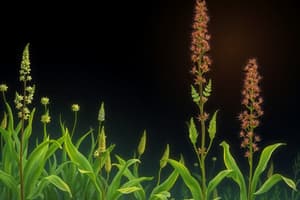Podcast
Questions and Answers
How is the plant family Poaceae pronounced?
How is the plant family Poaceae pronounced?
- Poe-ace
- Po-ah-see
- Po-A-C-E (correct)
- Poe-uh-see
The radicle is the secondary root in embryonic form.
The radicle is the secondary root in embryonic form.
False (B)
What are the three distinct parts of a cereal grain embryo?
What are the three distinct parts of a cereal grain embryo?
Plumule, radicle, and scutellum
The protective sheath around the radicle in grass species is called __________.
The protective sheath around the radicle in grass species is called __________.
What is the role of the shoot apical meristem (SAM) in the plumule?
What is the role of the shoot apical meristem (SAM) in the plumule?
The seminal root system may be replaced by the secondary adventitious root system during the plant's life cycle.
The seminal root system may be replaced by the secondary adventitious root system during the plant's life cycle.
The __________ is formed from the radicle and lateral seminal roots.
The __________ is formed from the radicle and lateral seminal roots.
Match the parts of a cereal grain embryo with their functions:
Match the parts of a cereal grain embryo with their functions:
Which of the following is a characteristic of dicotyledonous plants?
Which of the following is a characteristic of dicotyledonous plants?
Monocots always have two cotyledons in their seeds.
Monocots always have two cotyledons in their seeds.
What term describes the southern internode elongation type in monocotyledonous plants?
What term describes the southern internode elongation type in monocotyledonous plants?
In dicotyledonous plants, the two germination types are _______ and hypogeal germination.
In dicotyledonous plants, the two germination types are _______ and hypogeal germination.
Match the following terms with their correct definitions:
Match the following terms with their correct definitions:
Which plant part specializes in the absorption of the endosperm in monocots?
Which plant part specializes in the absorption of the endosperm in monocots?
What is the primary function of the coleoptile?
What is the primary function of the coleoptile?
The caryopsis is a type of fruit commonly associated with monocots.
The caryopsis is a type of fruit commonly associated with monocots.
Name one key difference between monocots and dicots.
Name one key difference between monocots and dicots.
The endosperm is located outside the embryo within the seed.
The endosperm is located outside the embryo within the seed.
What structure serves as a food storage role for the germinating grass seedling?
What structure serves as a food storage role for the germinating grass seedling?
The tiny leaves inside the seed are called the __________.
The tiny leaves inside the seed are called the __________.
What is the family name for wheat?
What is the family name for wheat?
Match the following components of a grass seed with their functions:
Match the following components of a grass seed with their functions:
Dicot plants have one cotyledon per seed.
Dicot plants have one cotyledon per seed.
Which of the following best describes the nature of cereal grains?
Which of the following best describes the nature of cereal grains?
What type of venation do monocot plants typically have?
What type of venation do monocot plants typically have?
Once the plumule emerges above the ground, it relies on stored food to survive.
Once the plumule emerges above the ground, it relies on stored food to survive.
The genus name for pea is ___________.
The genus name for pea is ___________.
The process by which plants manufacture their own food using sunlight is called __________.
The process by which plants manufacture their own food using sunlight is called __________.
Match the plant type with its characteristic:
Match the plant type with its characteristic:
Which of the following is NOT a characteristic of dicot plants?
Which of the following is NOT a characteristic of dicot plants?
Cereal grains are a member of the grass family (Poaceae).
Cereal grains are a member of the grass family (Poaceae).
What is the subclass for dicotyledons?
What is the subclass for dicotyledons?
What is the primary function of the aleurone layer in cereal grains?
What is the primary function of the aleurone layer in cereal grains?
Cereal grains have an outer layer called the testa which is derived from the ovary wall.
Cereal grains have an outer layer called the testa which is derived from the ovary wall.
What are the three basic parts that make up the dicot embryo?
What are the three basic parts that make up the dicot embryo?
The outer layer of a cereal grain is made up of the fused _______ and testa.
The outer layer of a cereal grain is made up of the fused _______ and testa.
Which of the following is NOT a pulse crop example mentioned?
Which of the following is NOT a pulse crop example mentioned?
Match the parts of a dicot embryo with their functions:
Match the parts of a dicot embryo with their functions:
What are the predominant oilseed crops grown in Saskatchewan?
What are the predominant oilseed crops grown in Saskatchewan?
Dicots have seeds that contain only one cotyledon.
Dicots have seeds that contain only one cotyledon.
What is the primary difference in food storage between dicot seeds and monocot seeds?
What is the primary difference in food storage between dicot seeds and monocot seeds?
The hilum is the visible scar on the testa where the seed was attached inside the fruit.
The hilum is the visible scar on the testa where the seed was attached inside the fruit.
What is the first organ to emerge during germination?
What is the first organ to emerge during germination?
In hypogeal germination, the cotyledons remain _____ the soil surface.
In hypogeal germination, the cotyledons remain _____ the soil surface.
Which type of germination is characteristic of all cereal crops?
Which type of germination is characteristic of all cereal crops?
Match the following terms with their definitions:
Match the following terms with their definitions:
Secondary adventitious roots develop from the _____ node.
Secondary adventitious roots develop from the _____ node.
What is the term for germination where cotyledons are raised above the soil surface?
What is the term for germination where cotyledons are raised above the soil surface?
Flashcards
Monocotyledon
Monocotyledon
A plant with one cotyledon (embryonic leaf) in its seed.
Dicotyledon
Dicotyledon
A plant with two cotyledons (embryonic leaves) in its seed.
Cotyledon
Cotyledon
An embryonic leaf in a seed that provides nutrition to the developing seedling.
Scutellum
Scutellum
Signup and view all the flashcards
Endosperm
Endosperm
Signup and view all the flashcards
Monocot embryo
Monocot embryo
Signup and view all the flashcards
Dicot embryo
Dicot embryo
Signup and view all the flashcards
Germination types in dicots
Germination types in dicots
Signup and view all the flashcards
Monocot Plant
Monocot Plant
Signup and view all the flashcards
Dicot Plant
Dicot Plant
Signup and view all the flashcards
Vascular Cambium
Vascular Cambium
Signup and view all the flashcards
Poaceae
Poaceae
Signup and view all the flashcards
Cereal Grain
Cereal Grain
Signup and view all the flashcards
Parallel Leaf Venation
Parallel Leaf Venation
Signup and view all the flashcards
Net/Branched Leaf Venation
Net/Branched Leaf Venation
Signup and view all the flashcards
Poaceae pronunciation
Poaceae pronunciation
Signup and view all the flashcards
Monocot embryo parts
Monocot embryo parts
Signup and view all the flashcards
Radicle
Radicle
Signup and view all the flashcards
Coleorhiza
Coleorhiza
Signup and view all the flashcards
Seminal root system
Seminal root system
Signup and view all the flashcards
Secondary adventitious root system
Secondary adventitious root system
Signup and view all the flashcards
Plumule
Plumule
Signup and view all the flashcards
Shoot apical meristem (SAM)
Shoot apical meristem (SAM)
Signup and view all the flashcards
Coleoptile
Coleoptile
Signup and view all the flashcards
Phototropic
Phototropic
Signup and view all the flashcards
Embryonic Axis
Embryonic Axis
Signup and view all the flashcards
Cereal Grain Fruit?
Cereal Grain Fruit?
Signup and view all the flashcards
Pericarp vs. Testa
Pericarp vs. Testa
Signup and view all the flashcards
Aleurone Layer
Aleurone Layer
Signup and view all the flashcards
What does the aleurone do?
What does the aleurone do?
Signup and view all the flashcards
What is bran?
What is bran?
Signup and view all the flashcards
What makes up the germ?
What makes up the germ?
Signup and view all the flashcards
Dicot Embryo Structure
Dicot Embryo Structure
Signup and view all the flashcards
Dicot Cotyledon Position
Dicot Cotyledon Position
Signup and view all the flashcards
Dicot Seed Endosperm
Dicot Seed Endosperm
Signup and view all the flashcards
Testa
Testa
Signup and view all the flashcards
Hilum
Hilum
Signup and view all the flashcards
Micropyle
Micropyle
Signup and view all the flashcards
Hypogeal Germination
Hypogeal Germination
Signup and view all the flashcards
Epigeal Germination
Epigeal Germination
Signup and view all the flashcards
Study Notes
Crop Emergence & Development
- Learning Objectives:
- Distinguish between monocot and dicot embryos
- Describe differences between monocots and dicots
- List and describe two dicot germination types
- Identify two monocot internode elongation types
Key Terms and Concepts
- aleurone layer: A layer of cells containing high protein content, that secretes hydrolytic enzymes to digest food reserves.
- bran: The outermost layer of the cereal grain, consisting of the pericarp, testa, and aleurone layer.
- hull: The outer covering of a seed, often in grasses.
- bran: The outer layer of the cereal grain consisting of the pericarp, testa, and aleurone layer.
- caryopsis: The fruit of cereal grains; a small dry fruit with the pericarp fused with the seed coat (testa).
- cereal grain: A cereal grain is a fruit—a seed derived from the ovary wall of a flower.
- coleoptile: A protective sheath surrounding the plumule in monocots.
- coleorhiza: A sheath protecting the radicle in monocots.
- cotyledon: An embryonic structure that provides food for the germinating seedling; monocots have one, dicots have two.
- dicotyledon: Plant with two cotyledons in the seed.
- embryo: The early developmental stage of a plant within the seed.
- embryonic axis: The central column that contains the radicle and the plumule.
- endosperm: A food storage tissue found in cereal grains, supplying the germinating seedling.
- epicotyl: The part of the stem above the cotyledons.
- epigeal germination: Cotyledons are raised above the soil surface.
- fruit: The mature ovary of a flower that contains seeds.
- germ: Consists of the plumule, radicle and cotyledon (scutellum).
- germination: The process of a seed developing into a plant.
- grain: A single seed or fruit of a cereal plant.
- hilum: The scar on a seed where it was attached to the ovary.
- hypocotyl: The part of the stem below the cotyledons.
- hypogeal germination: Cotyledons remain below the soil surface.
- mesocotyl: Underground stem in some grasses that pushes the coleoptile upward.
- micropyle: A small opening in the seed coat allowing entry of moisture.
- monocotyledon: Plant with a single cotyledon in the seed.
- plumule: Embryonic shoot that develops into the above-ground plant parts (leaves).
- Poaceae: Grasses family
- radicle: Embryonic root, the first part to emerge.
- scutellum: Specialized cotyledon in monocots for absorbing endosperm.
- seminal root system: Root system in younger plants developed from the radicle and lateral roots.
- secondary adventitious root system: Main, sustaining root system in grasses, develops from coleoptilar node
- shoot apical meristem (SAM): Growth point between two pre-formed leaves.
- sub-crown internode: underground stem in grasses
- testa: The seed coat
- sub-crown internode: Underground stem in grasses.
- testa: The seed coat
- testa: Seed coat.
- vascular cambium: Layer that enables dicots grow in width
- hypogeal: below the earth
- epigeal: above the earth
- embryo: A plant's first stage of development within a seed.
Introduction to Monocots and Dicots
- Monocots have one cotyledon, and dicots have two.
- This is a key difference used to classify plants into major groups.
- Cotyledon number is reliable and foundational in plant classification.
Monocots (Cereals)
- Cereal grains are members of the grass family (Poaceae).
- Cereal grain is a dry fruit.
Dicots (Oilseeds and Pulses)
- Oilseeds include canola, sunflower, and others.
- Pulses are crops like peas and lentils.
- Dicots characteristically have two cotyledons, which accounts for one method of classifying them.
Germination and Emergence
- Germination is the initial stages of seedling development starting within the seed.
- Seed emergence types are described as either hypogeal or epigeal, based on cotyledon position relative to the soil when germination is complete.
Studying That Suits You
Use AI to generate personalized quizzes and flashcards to suit your learning preferences.




